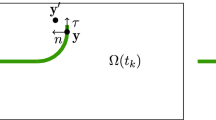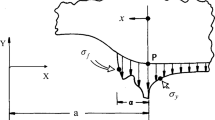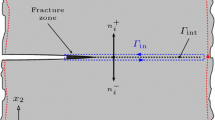Abstract
The speeds of fast running cracks in a range of quasi-brittle materials are measured as a function of the dynamic strain energy release rate. From the results, the heat output associated with the plastic work at the crack tip is calculated as a function of crack speed using an energy balance, and compared with the heat outputs determined experimentally using an energy method. A generally good agreement is found between the calculated and the experimentally measured variation of heat output with crack speed.
Résumé
Les vitesses de propagation des fissures en développement rapide dans une gamme de matériaux quasi-fragile sont mesurés en fonction de la vitesse de relaxation de l'énergie de déformation dynamique. A partir des résultats obtenus, on calcule la dissipation de chaleur associée au travail de formation plastique à l'extrémité de la fissure en fonction de la vitesse de la fissure correspondant à un équilibre énergétique. On compare ces valeurs calculées avec les dissipations de chaleur déterminées expérimentalement à l'aide d'une méthode énergétique. En général, on trouve un bon accord entre les variations de dissipation de chaleur calculées et mesurées par voie expérimentale en fonction de la vitesse de fissuration.
Zusammenfassung
Die Geschwindigkeiten schnell-laufender Brüche werden als Funktion der dynamischen Energiefreisetzungsrate für eine Anzahl unterschiedlich spröder Materialien gemessen. Aus diesen Ergebnissen wird mit Hilfe einer Energiebilanz die durch die plastischen Deformationen an der Rißspitze entstehende Wärme berechnet und mit der durch eine Energiemethode experimentell gemessenen Wärme verglichen. Es wird eine im allgemeinen gute Übereinstimmung zwischen dem berechneten und gemessenen Verlauf der Wärme als Funktion der Bruchgeschwindigkeit gefunden.
Similar content being viewed by others
References
N. F. Mott, Engineering, 165 (1948) 16–18.
D. K. Roberts and A. A. Wells, Engineering, 178 (1954) 820–821.
E. N. Dulaney and W. F. Brace, Journal of Applied Physics, 31 (1960) 2233–2236.
J. P. Berry, Journal of Applied Physics, 33 (1962) 226–227.
F. Erdogan, in Fracture Vol. II, ed. by H. Liebowitz, Academic Press, New York (1968) 497–590.
F. Kerkhof, Bruchvorgänge in Gläsern, Verlag der Deutschen Glastechnischen Gesellschaft, Frankfurt/Main, Germany (1970).
H. Küppers, International Journal of Fracture Mechanics, 3 (1967) 13–17.
P. Manogg, in Physics of Non-Crystalline Solids, ed. by J. A. Prins, North-Holland Publishing Company, Amsterdam (1965) 481–490.
W. S. Farren and G. J. Taylor, Proceedings of the Royal Society, London A 107 (1922) 422–451.
G. Manitz, Über den Bruchvorgang bei verschiedenen Hochpolymeren, Dissertation, Universität Freiburg, Germany (1959).
K. B. Broberg, Arkiv för Fysik, 18 (1960) 159–192.
B. Cotterell, Applied Materials Research, 4 (1965) 227–232.
H. Bergkvist, Journal of the Mechanics and Physics of Solids, 21 (1973) 229–239.
W. Döll, Engineering Fracture Mechanics, 5 (1973) 259–268.
L. B. Freund, Journal of the Mechanics and Physics of Solids, 20 (1972) 129–140.
L. B. Freund, Journal of the Mechanics and Physics of Solids, 20 (1972) 141–152.
H. Bergkvist, Numerical treatment of a brittle crack extending at non-uniform velocity, Report April, 1974, Lund Institute of Technology, Lund, Sweden.
F. Nilsson, International Journal of Fracture Mechanics, 8 (1972) 403–411.
T. L. Paxson and R. A. Lucas, in Dynamic crack propagation, ed. by G. C. Sih, Noordhoff International Publishing, Leyden (1973) 415–426.
A. A. Wells, Welding Research, 7 (1953) 34r-35r.
W. Döll, Wissensch. Bericht 4/74, Institut für Festkörpermechanik, Freiburg, Germany, (1974).
H. S. Carslaw and J. C. Jaeger, Conduction of Heat in Solids, second edition, Oxford University Press, Oxford, England (1959).
W. Döll, Journal of Materials Science, 10 (1975) 935–942.
P. Manogg, International Journal of Fracture Mechanics, 2 (1966) 604–613.
W. Döll, Colloid & Polymer Science, 252 (1974) 880–885.
Ad. Engelter and F. H. Müller, Kolloid-Zeitschrift, 157 (1958) 89–111.
R. A. Lucas, International Journal of Solids and Structures, 5 (1969) 175–190.
Author information
Authors and Affiliations
Rights and permissions
About this article
Cite this article
Döll, W. Application of an energy balance and an energy method to dynamic crack propagation. Int J Fract 12, 595–605 (1976). https://doi.org/10.1007/BF00034645
Received:
Published:
Issue Date:
DOI: https://doi.org/10.1007/BF00034645




